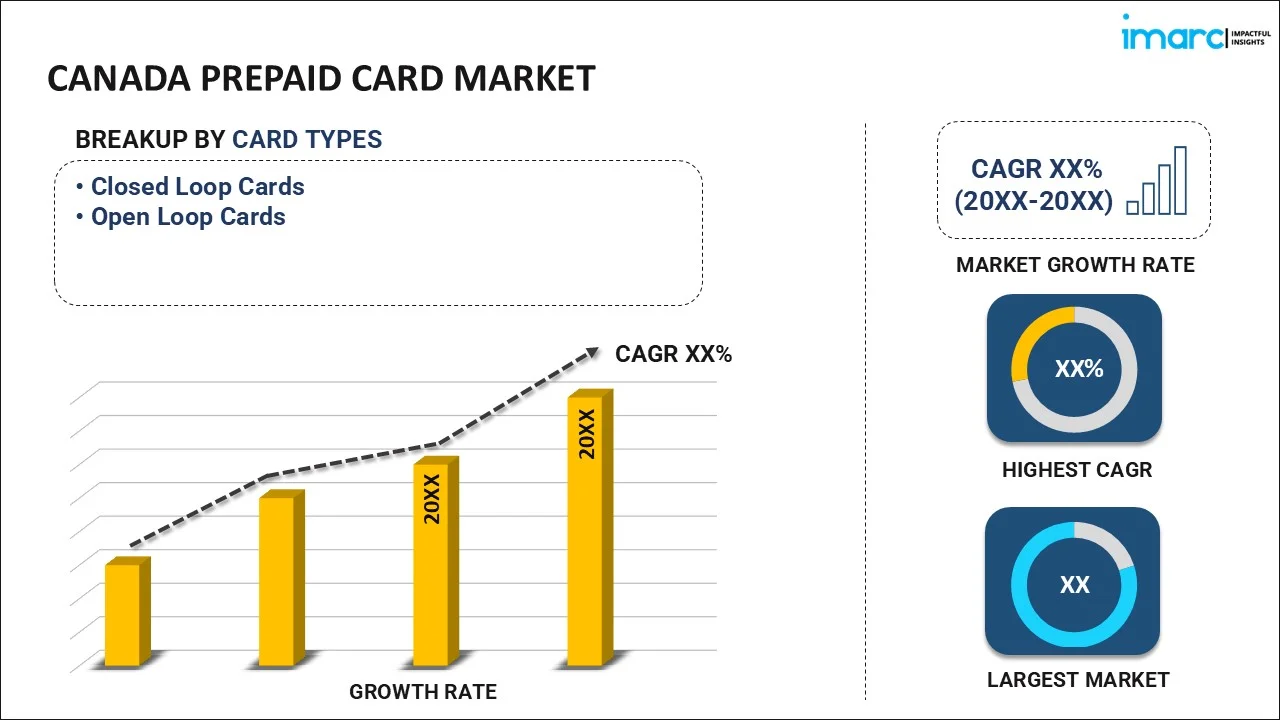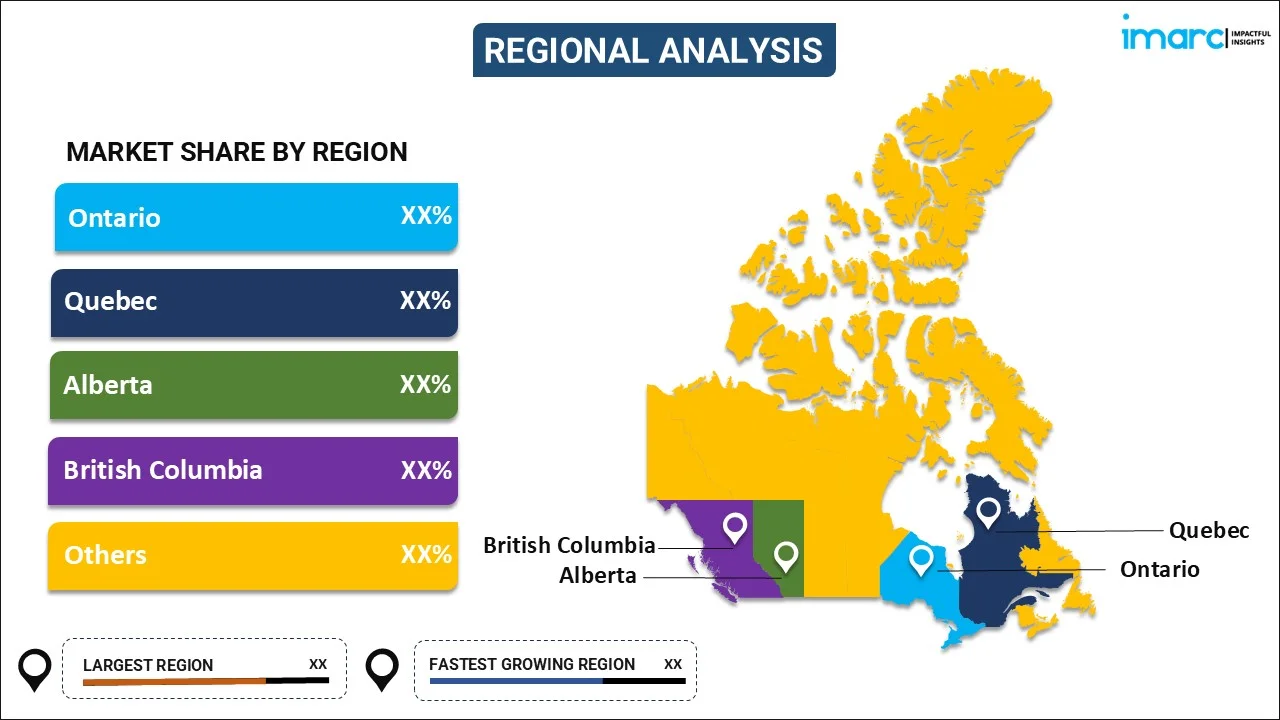
Canada Prepaid Card Market Size, Share, Trends and Forecast by Card Type, Purpose, Vertical, and Region, 2025-2033
Canada Prepaid Card Market Size and Share:
The Canada prepaid card market size reached USD 6.38 Billion in 2024. Looking forward, IMARC Group expects the market to reach USD 16.84 Billion by 2033, exhibiting a growth rate (CAGR) of 10.40% during 2025-2033. The increasing consumer demand for convenient payment solutions, rising adoption of digital payments, expansion in retail distribution channels, government initiatives promoting financial inclusion, and the versatility of prepaid cards for budgeting and gifting are some of the key factors aiding in market expansion.
|
Report Attribute
|
Key Statistics
|
|---|---|
|
Base Year
|
2024
|
|
Forecast Years
|
2025-2033
|
|
Historical Years
|
2019-2024
|
| Market Size in 2024 | USD 6.38 Billion |
| Market Forecast in 2033 | USD 16.84 Billion |
| Market Growth Rate (2025-2033) | 10.40% |
Canada Prepaid Card Market Trends:
Shift to Digital and Contactless Payments
One of the drivers of the expansion of the Canada prepaid card market is the growing use of digital and contactless payment options. With consumers increasingly valuing convenience and security in their transactions, prepaid cards offer a feasible substitute for conventional payment methods. Prepaid cards can be reloaded online, via mobile apps, to make payments easily and securely without holding real cash or even a real card. Additionally, technological and infrastructural developments serve as a catalyst in the payment digitalization process. Contactless payments make up 63% of total purchases made in stores in 2023, reflecting a 17% rise compared to the last year. Payment processors and financial institutions have become more efficient in handling contactless payments, thus making prepaid cards increasingly attractive to consumer-friendly shoppers who prioritize convenience and speed.
Expansion of Use Cases Beyond Traditional Banking
The other major trend affecting the Canada prepaid card market is the widening of use cases from conventional banking applications. Initially seen as instruments for gifting or budgeting, prepaid cards are increasingly being integrated into other financial systems to support a wider variety of requirements. For example, companies are more and more adopting prepaid cards for payroll distribution, employee rewards, and expense reimbursement, taking advantage of the flexibility and convenience of the cards. Also, prepaid cards are increasingly becoming popular among the underbanked and unbanked communities that do not necessarily have access to mainstream banking facilities. These cards offer a channel through which individuals without a bank account can engage in electronic payments, online purchasing, and other financial transactions previously out of their reach. With financial inclusion ranking higher on the agenda of governments and organizations, prepaid cards are at the forefront of filling the gaps and providing financial empowerment to excluded groups.
Integration of Enhanced Security Features and Consumer Protection
Security concerns continue to influence consumer preferences in the prepaid card market, prompting issuers and financial institutions to prioritize enhanced security features and consumer protection measures. Prepaid cards are equipped with advanced security technologies such as EMV chips, encryption protocols, and real-time transaction monitoring to safeguard against fraud and unauthorized access. These features not only protect consumers' funds but also enhance trust and confidence in prepaid card usage. Furthermore, regulatory frameworks and industry standards enforcing guidelines on data protection, fraud prevention, and dispute resolution to ensure that consumers are adequately protected against financial risks are impelling the market growth.
Canada Prepaid Card Market Segmentation:
IMARC Group provides an analysis of the key trends in each segment of the market, along with forecasts at the regional level for 2025-2033. Our report has categorized the market based on card type, purpose, and vertical.
Card Type Insights:

- Closed Loop Cards
- Open Loop Cards
The report has provided a detailed breakup and analysis of the market based on the card type. This includes closed loop cards, and open loop cards.
Purpose Insights:
- Payroll/Incentive Cards
- Travel Cards
- General Purpose Reloadable (GPR) Cards
- Remittance Cards
- Others
A detailed breakup and analysis of the market based on the purpose have also been provided in the report. This includes payroll/incentive cards, travel cards, general purpose reloadable (GPR) cards, remittance cards, and others.
Vertical Insights:
- Corporate/Organization
- Retail
- Government
- Others
The report has provided a detailed breakup and analysis of the market based on the vertical. This includes corporate/organization, retail, government, and others.
Regional Insights:

- Ontario
- Quebec
- Alberta
- British Columbia
- Others
The report has also provided a comprehensive analysis of all the major regional markets, which include Ontario, Quebec, Alberta, British Columbia, and others.
Competitive Landscape:
The market research report has also provided a comprehensive analysis of the competitive landscape. Competitive analysis such as market structure, key player positioning, top winning strategies, competitive dashboard, and company evaluation quadrant has been covered in the report. Also, detailed profiles of all major companies have been provided.
Canada Prepaid Card Market News:
- In February 2025, Prepayster.com launched on February 1, 2025, offering global access to prepaid cards, mobile top-ups, and digital gift vouchers. The platform provides secure, flexible, and bank-free financial solutions, catering to consumers seeking alternative digital payments. With a focus on accessibility and convenience, Prepayster.com aims to expand financial inclusion worldwide, enabling seamless transactions without traditional banking requirements. This launch strengthens the growing demand for digital payment solutions, enhancing user experience with a secure and efficient platform for prepaid financial services.
- In March 2024, together with Mastercard and Payfare, Uber launched the Uber Pro Card in Canada. The no-fee card gives drivers and delivery people on the Uber platform free instant payouts after every trip or delivery and richer loyalty features: Exclusive cashback rewards help drivers and delivery people save up to 4% on gas, and up to 8% on EV charging. Customers will also be eligible to use the Backup Balance feature, which allows them to access up to $50 when they need it most.
Canada Prepaid Card Market Report Coverage:
| Report Features | Details |
|---|---|
| Base Year of the Analysis | 2024 |
| Historical Period | 2019-2024 |
| Forecast Period | 2025-2033 |
| Units | Billion USD |
| Scope of the Report |
Exploration of Historical Trends and Market Outlook, Industry Catalysts and Challenges, Segment-Wise Historical and Future Market Assessment:
|
| Card Types Covered | Closed Loop Cards, Open Loop Cards |
| Purposes Covered | Payroll/Incentive Cards, Travel Cards, General Purpose Reloadable (GPR) Cards, Remittance Cards, Others |
| Verticals Covered | Corporate/Organization, Retail, Government, Others |
| Regions Covered | Ontario, Quebec, Alberta, British Columbia, Others |
| Customization Scope | 10% Free Customization |
| Post-Sale Analyst Support | 10-12 Weeks |
| Delivery Format | PDF and Excel through Email (We can also provide the editable version of the report in PPT/Word format on special request) |
Key Questions Answered in This Report:
- How has the Canada prepaid card market performed so far and how will it perform in the coming years?
- What is the breakup of the Canada prepaid card market on the basis of card type?
- What is the breakup of the Canada prepaid card market on the basis of purpose?
- What is the breakup of the Canada prepaid card market on the basis of vertical?
- What is the breakup of the Canada prepaid card market on the basis of region?
- What are the various stages in the value chain of the Canada prepaid card market?
- What are the key driving factors and challenges in the Canada prepaid card?
- What is the structure of the Canada prepaid card market and who are the key players?
- What is the degree of competition in the Canada prepaid card market?
Key Benefits for Stakeholders:
- IMARC’s industry report offers a comprehensive quantitative analysis of various market segments, historical and current market trends, market forecasts, and dynamics of the Canada prepaid card market from 2019-2033.
- The research report provides the latest information on the market drivers, challenges, and opportunities in the Canada prepaid card market.
- Porter's five forces analysis assist stakeholders in assessing the impact of new entrants, competitive rivalry, supplier power, buyer power, and the threat of substitution. It helps stakeholders to analyze the level of competition within the Canada prepaid card industry and its attractiveness.
- Competitive landscape allows stakeholders to understand their competitive environment and provides an insight into the current positions of key players in the market.
Need more help?
- Speak to our experienced analysts for insights on the current market scenarios.
- Include additional segments and countries to customize the report as per your requirement.
- Gain an unparalleled competitive advantage in your domain by understanding how to utilize the report and positively impacting your operations and revenue.
- For further assistance, please connect with our analysts.
 Inquire Before Buying
Inquire Before Buying
 Speak to an Analyst
Speak to an Analyst
 Request Brochure
Request Brochure
 Request Customization
Request Customization




.webp)




.webp)












